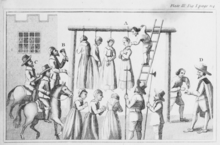In Newcastle upon Tyne, witch trials were conducted in the 17th century, during an era of social and religious turmoil. Many people were accused, tried and executed for allegations of being a witch.


History
editBackground
editThe history of the Newcastle witch trials starts in Scotland. The extension of the Witchcraft Act in 1649 sparked a intense witch hunting period.[1] This spilled into the north of England and in Newcastle.[1] 1649 saw Puritan Magistrates at Newcastle send two sergeants, Thomas Shevel and Cuthbert Nicholson, to Scotland to bring an un-named Scottish witch-finder to try witches in Newcastle.[1][2][3]
A town crier sent through the town would cry "All people that would bring in any complaint against any woman for a witch".[2][3] This led to 30 women being brought into the town hall. The 30 suspected witches were held in New Gate Gaol in the lead up to their trials.[3] One witch, Jane Martin, was held in the dungeon at Newcastle Castle, as this was her native county prison in Northumberland.[3]
Trials
editA year later, in the guildhall at Newcastle's Quayside, the 31 trials of the accused took place.[3] Following these trials, 16 were found guilty and hanged on 21 August 1650 alongside criminals convicted of other crimes.[2][3] These hangings drew a large audience, as the events were treated as entertainment.[3]
One of the convicted, Margaret Brown, asked that God give a remarkable sign that could prove her innocence.[2][3] As soon as she was taken from the ladder, blood gushed from her neck onto the onlookers.[2]
List of Accused
edit| Name[2] | Execution | Date |
|---|---|---|
| Matthew Bulmer | Executed | 21 August 1650 |
| Elizabeth Anderson | Executed by hanging | |
| Jane Hunter | Executed by hanging | |
| Mary Potts | Executed by hanging | |
| Alice Hume | Executed by hanging | |
| Margaret Muffit | Executed by hanging | |
| Margaret Maddison | Executed by hanging | |
| Elizabeth Brown | Executed by hanging | |
| Margaret Brown | Executed by hanging | |
| Jane Copeland | Executed by hanging | |
| Ann Watson | Executed by hanging | |
| Elianor Henderson | Executed by hanging | |
| Elizabeth Dobson | Executed by hanging | |
| Katherine Coultor | Executed by hanging | |
| Elianor Rogerson | Executed by hanging | |
| Jane Martin[4] | Executed by hanging | |
| Margaret White (sister of Jane Martin)[4] | Confessed on behalf of her sister, thus was also hung | |
| Dorothy Swinhoe[4] | Unknown whether executed | |
| Ann Menin[4] | Unknown whether executed |
The Witchfinder
editIntroduction
editWitchfinders were people who were paid to test whether someone was a witch.
The witchfinder in Newcastle witch trials came from Scotland.[4] He was paid 20 shillings[2] per "witch" he found.
In the end, the witchfinder in Newcastle trials was cast into prison.[1]
Action and Role
editThe witchfinder used a pin to prick the accused on their thigh. If no blood came out, the accused was determined to be a witch.
Experience of the event
editIn July 1649, the Puritan Magistrates at Newcastle commissioned a witchfinder to try witches.[4] 30 women were accused as witches. As a result of Preston's rumour, all 30 were arrested and jailed awaiting trial.
Motivations and accusations
editThe Newcastle witch trials emerged as a result of political unrest, religious reform and personal disputes,[1] and these became motivations for hunting and persecuting those believed to be witches.
Religion
editBecause of witches' supposed association with the devil, religion was influential in the city's decision to hold witch trials.[1] This belief was built on during the trials.
The Influence of the Civil War
editThe English Civil War (1642–1651) created a political unrest in the UK between Parliamentarians and Catholics. Charles struggled before parliament before starting a "tyrannical" eleven years of rule in which parliament was not assembled.[5] King Charles I was imprisoned in Newcastle upon Tyne from 1646–47, at the time of which Jane Martin's accusations.[6]
Jane Martin
editJane Martin and her sister Margaret White were among the accused women. Jane Martin was accused of witchcraft for being servant to the devil for five years. It was claimed the devil and her would eat together. Jane Martin was accused of being responsible for the death of a man (Thomas Young) by manipulating a kiln of oats to explode using the will of her mind. Margaret confessed on behalf of the sisters and both Margaret White and Jane Martin were hanged in 1650 with other accused witches on Town Moor.[4][6]
References
edit- ^ a b c d e f Clayton, Rebecca (30 October 2020). "The Newcastle Witch Trial". Medium. Retrieved 24 October 2024.
- ^ a b c d e f g Gardiner, Ralph (1849) [1655]. England's Grievance Discovered: In Relation to the Coal-trade; the Tyrannical Oppression of the Magistrates of Newcastle; Their Charters and Grants; the Several Tryals, Depositions, and Judgements Obtained Against Them; with a Breviate of Several Statutes Proving Repugnant to Their Actings; with Proposals for Reducing the Excessive Rates of Coals for the Future; and the Rise of Their Grants Appearing in this Book. Philipson and Hare.
- ^ a b c d e f g h Reader, Emily (22 August 2024). "Newcastle witch trials: A little known history and one of the largest mass hangings in nation's past". ITV News. Retrieved 24 October 2024.
- ^ a b c d e f g Bath, J (2002). Dancing with the devil and other true tales of Northern witchcraft. Newcastle upon Tyne: Tyne Bridge Publishing. pp. 36–42.
- ^ "English Civil Wars | Causes, Summary, Facts, Battles, & Significance | Britannica". www.britannica.com. 2024-09-14. Retrieved 2024-10-24.
- ^ a b "Castle Characters - Jane Martin". Newcastle Castle. Retrieved 24 October 2024.